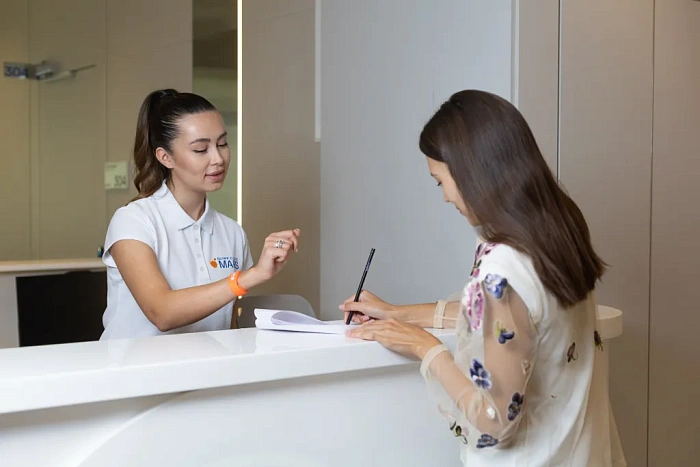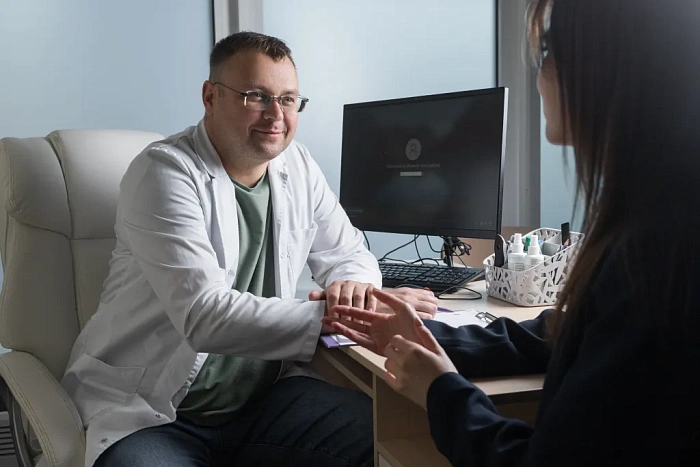Crohn's disease diagnostics and treatment
Eliminating inflammation, preventing complications, and ensuring long-term remission in Crohn's disease.

Crohn's disease is a chronic inflammatory condition affecting any part of the gastrointestinal tract, usually the ileum. The disease is accompanied by abdominal pain, diarrhea, and weight loss.
Crohn's disease is characterized by inflammation in the deeper layers of the intestinal wall, which can lead to the formation of ulcers, fistulas, and strictures. These changes cause intestinal symptoms as well as extraintestinal manifestations, which may affect the joints, skin, and eyes. Treatment involves anti-inflammatory medication, dietary restrictions, and patient monitoring. Complex cases may require surgical intervention.
The primary diagnostic method is a colonoscopy with biopsy, which helps detect characteristic inflammatory changes and granulomas. Additionally, barium X-ray, CT, or MRI are used to assess the extent of the lesion and identify any complications. Capsule endoscopy provides visual insights into areas of the small intestine that are otherwise inaccessible.
The treatment combines drug therapy and dietary restrictions. The patient is prescribed anti-inflammatory and symptomatic drugs, including painkillers, antiemetics, and laxatives. Proper diet is key: fatty, fried, spicy, and rough foods are replaced by soft and easily digestible options. Severe cases, such as intestinal obstruction, fistulas, or massive bleeding, require surgical intervention. During the procedure, the affected section of the intestine is removed, while its patency is restored.
Patients require time to recover from surgery, from several weeks to months. To ensure a swift recovery, patients are advised to follow a light routine, maintain a balanced diet, and avoid intense physical activity.
Benefits
Early diagnosis
Modern methods make it possible to detect the disease at an early stage.
Comprehensive treatment
Therapy is aimed at relieving symptoms and preventing complications.
Individual approach
Treatment is selected based on the severity and characteristics of the disease.
Improving the quality of life
Proper therapy reduces the frequency of exacerbations and allows you to lead a full-fledged lifestyle.
Diagnostics
The main diagnostic method is colonoscopy with biopsy, which allows to identify characteristic inflammatory changes and granulomas. Additionally, X-ray examinations with barium, CT or MRI are performed to assess the extent of the lesion and identify complications. Capsule endoscopy helps to visualize areas of the small intestine that are inaccessible with other methods.

Treatment
The basis of therapy is drug treatment in combination with diet. The patient is prescribed anti-inflammatory drugs, as well as symptomatic drugs: painkillers, antiemetics, laxatives. Diet plays a key role: fatty, fried, spicy and coarse foods are excluded, preference is given to soft, easily digestible foods. In severe cases, such as intestinal obstruction, fistulas, or massive bleeding, surgical treatment is used. During the operation, the affected area of the intestine is removed, followed by restoration of its patency.

Recovery
After surgery, the patient needs time to recover, which can take from several weeks to months. It is recommended to follow a gentle regime, diet and avoid physical exertion.

Frequently Asked Questions
How to prevent flare-ups?
Doctor: Tarasov Vladimir Alexandrovich
What is the prognosis for Crohn's disease?
Doctor: Tarasov Vladimir Alexandrovich
Didn't find an answer to your question?
You can describe your problem in detail and ask a question to the doctor. He will answer you and help you find a solution
Specialists
Find a SpecialistA coloproctologist, a surgeon.
Similar referral activities
Hemorrhoid diagnostics and treatment
Effective solution to hemorrhoids: from nonsurgical treatment to minimally invasive and surgical procedures.
Nonspecific ulcerative colitis diagnostics and treatment (NUC)
A comprehensive approach to NUC diagnostics and treatment to control inflammation and achieve remission.
Coloproctologist consultation
Appointment with a coloproctologist to diagnose, treat and prevent diseases of the rectum, anal canal and colon.
How to reach
How to get
From the Belorusskaya metro station of the Zamoskvoretskaya line - exit 4 After exiting the subway, walk through the pedestrian tunnel and climb the stairs. Move towards the railway tracks, go down the stairs immediately after them and walk along the house, then turn right onto 1st Yamskoye Pole Street. At the turn to 3rd Yamsky Pole Street, cross the road at the pedestrian crossing and continue along 1st Yamsky Field Street, after a few buildings on the left you will see Olympus Clinic MARS.
Travel time
9 minutes
Landmark
Olympus Clinic MARS sign
How to get
From the Belorusskaya metro station of the Ring line - exit 2. After exiting the subway, turn left and walk to the pedestrian crossing. Cross the road through two pedestrian crossings and move along the Tverskoy overpass. Go down the stairs immediately after the railway tracks, walk along the house, then turn right onto 1st Yamskoye Pole Street. At the turn to 3rd Yamsky Pole Street, cross the road at the pedestrian crossing and continue along 1st Yamsky Field Street, after a few buildings on the left you will see Olympus Clinic MARS
Travel time
11 minutes
Landmark
Olympus Clinic MARS sign
From the metro station "Tsvetnoy Bulvar"
1 exit to the city, then left to the Garden Ring, at the crossing to the right, crossing the boulevard, one more crossing and at the traffic light to the left. The Olymp Clinic building is located overlooking the Garden Ring to the right of the crossing. Travel time is approximately 9 minutes. Landmark - sign Olymp Clini
From the metro station "Sukharevskaya"
Exit 3 from the metro and 640 meters straight ahead, the clinic will be on the right. Landmark - sign Olymp Clinic
Parking lot map
Exit 3 from the metro and 640 meters straight ahead, the clinic will be on the right. Landmark - sign Olymp Clinic

From Sokol metro station
The last car from the center: follow the signs for Exit 5. From the glass doors to the right and go to the end of the passage. Exit to the city by the steps to the left. After exiting the crossing to the street, go straight along Leningradsky Prospekt to the intersection with Chapaevsky Lane. Next, turn right (onto Chapaevsky Lane) and walk to the Triumph Palace residential complex. Entrance to the territory: through checkpoint No. 1, opposite the Vkusville store, you will need to present your passport. After passing through the checkpoint, go up the stairs to the fountain, opposite it you will see our clinic.
Travel time
10-12 minutes
From the Airport metro station
The first car from the center: follow the Exit 2-3 signs. Turn left out of the glass doors and walk to the end of the passage. After exiting the crossing to the street, go straight along Leningradsky Prospekt to the intersection with Chapaevsky Lane. Next, turn left (onto Chapaevsky Lane) and walk to the Triumph Palace residential complex. Entrance to the territory: through checkpoint No. 1, opposite the Vkusville store, you will need to present your passport. After passing through the checkpoint, go up the stairs to the fountain, opposite it you will see our clinic.
Travel time
12-15 minutes
How to get
Entry to the territory is prohibited, but there are free city parking lots around the Triumph Palace residential complex, where you can easily find a place for your car. Free parking area:




